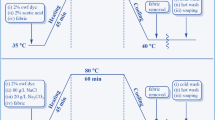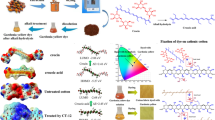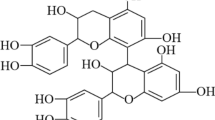Abstract
The environmental toxicity concerns raised by the synthetic origin pigments have lead to escalating interest towards natural pigments. In the present study, prodigiosin type biochrome- a member of prodiginine dye family was obtained from indegenously isolated bacterial strain Serratia sp. KH-1. Cultural and physiological parameters for production of pigment along with its application on dyeing fabrics have been studied. The identity of prodigiosin type biochrome was confirmed by fourier transform infrared (FT-IR) spectroscopy, mass spectroscopy and nuclear magnetic resonance (NMR). The detailed dyeing ability of this biochrome was evaluated using cotton and wool fabrics. The fabric showed the maximum dye uptake (K/S) at of 50 ℃ for 50 min duration, and 4.3 g/l dye concentration. Pre-mordanting by sodium chloride proved to be effective on increasing K/S values of the dyed fabrics under the optimum dyeing conditions. Fastness ratings to washing and light showed acceptable fastness for both cotton and wool fabrics. Hence, the present study represents the application and detailed investigation of prodigiosin type biochrome for textile dyeing using mordants. This study will thus, be helpful for designing the dyeing protocol for cotton and wool fabrics using eco-friendly pigment.
Similar content being viewed by others
Explore related subjects
Discover the latest articles and news from researchers in related subjects, suggested using machine learning.References
S. Moosvi, X. Kher, and D. Madamwar, Dyes Pigment., 74, 723 (2007).
S. Ghodake, A. Telke, P. Jadhav, and P. Govindwar, Int. J. Phytoremediat., 11, 297 (2009).
K. Hobson and S. Wales, J. Soc. Dyers Colour., 114, 42 (1998).
N. Durán, S. Teixeira, R. Conti, and E. Esposito, Crit. Rev. Food Sci. Nutr., 42, 53 (2002).
S. Chang, M. Sanada, O. Johdo, S. Ohta, Y. Nagamatsu, and A. Yoshimoto, Biotechnol. Lett., 22, 1761 (2000).
V. Giri, N. Anandkumar, G. Muthukumaran, and G. Pennathur, BMC Microbiol., 4, 1 (2004).
C. Araújo, K. Fukushima, and C. Takaki, Molecules, 15, 6931 (2010).
H. Wei, J. Yu, and C. Chen, J. Biosci. Bioeng., 100, 466 (2005).
P. Harris, N. Williamson, H. Slater, A. Cox, S. Abbasi, I. Foulds, T. Simonsen, F. Leeper, and G. Salmond, Microbiology, 150, 3547 (2004).
A. Furstner, Angew. Chem.-Int. Edit., 42, 3582 (2003).
K. Venil and P. Lakshmanaperumalsamy, Electron. J. Biol. 5, 49 (2009).
A. Khanafari, M. Assadi, and A. Fakhr, Online J. Biol. Sci., 6, 1 (2006).
F. Alihosseini, L. Kou-San, H. Bruce, and S. Gang, Biotechnol. Prog., 24, 742 (2008).
C. Gulani, S. Bhattacharya, and A. Das, Malaysian J. Microbiol., 8, 116 (2012).
S. Shahitha and K. Poornima, J. Appl. Pharma. Sci., 2, 138 (2012).
J. Vaidyanathan, Z. Bhathena-Langdana, V. Adivarekar, and M. Nerurkar, Appl. Biochem. Biotechnol., 166, 321 (2012).
M. Ausubel, R. Brent, E. Kingston, D. Moore, A. Seidman, and G. Smith, “Current Protocols in Molecular Biology” [unit 24], John Wiley and Sons, New York, 1997.
H. Pathak, S. Patel, M. Rathod, and K. Chauhan, Bioresour. Technol., 120, 10391 (2011).
H. Pathak, D. Kantharia, A. Malpani, and D. Madamwar, J. Hazard. Mater., 166, 1466 (2009).
G. Britton in “The Biochemistry of Natural Pigment”, University Press, Cambridge, Great Britain, 1983.
J. Song, J. Bae, S. Lee, H. Kim, S. Kim, W. Kim, and S. Hong, J. Biosci. Bioeng., 101, 157 (2006).
G. Zhong, Master Dissertation, China, 2011.
Author information
Authors and Affiliations
Corresponding author
Rights and permissions
About this article
Cite this article
Chauhan, K., Dalsaniya, P. & Pathak, H. Optimization of prodigiosin-type biochrome production and effect of mordants on textile dyeing to improve dye fastness. Fibers Polym 16, 802–808 (2015). https://doi.org/10.1007/s12221-015-0802-6
Received:
Revised:
Accepted:
Published:
Issue Date:
DOI: https://doi.org/10.1007/s12221-015-0802-6




